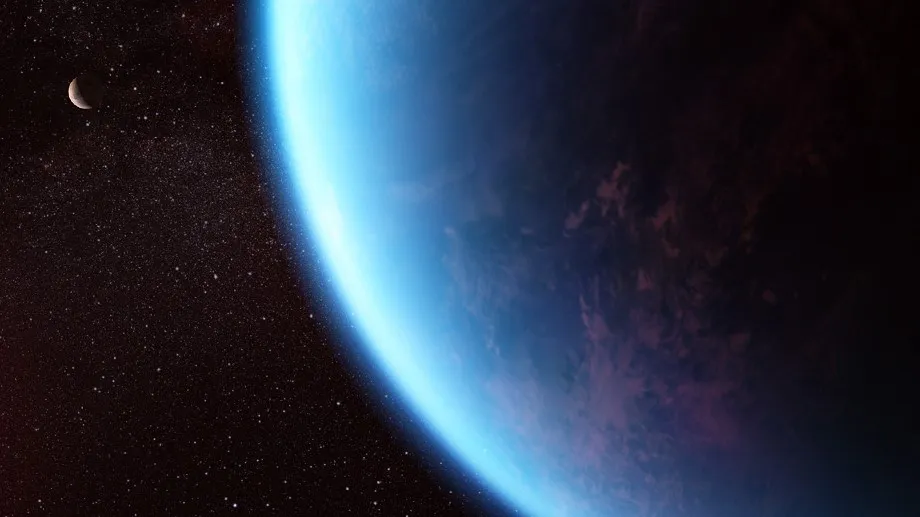Astronomers “closed” life on planet K2-18
- May 3, 2024
- 0
Last year, scientists discovered dimethyl sulfide, a compound that only living organisms on our planet can synthesize, in the atmosphere of an exoplanet 124 light-years from Earth. Using
Last year, scientists discovered dimethyl sulfide, a compound that only living organisms on our planet can synthesize, in the atmosphere of an exoplanet 124 light-years from Earth. Using

Last year, scientists discovered dimethyl sulfide, a compound that only living organisms on our planet can synthesize, in the atmosphere of an exoplanet 124 light-years from Earth. Using rather complex methods, the authors of the new study cast doubt on its presence there.
The red dwarf K2-18 is located relatively close to the Sun and was only discovered in 2015, as it has a mass half that of the Sun, making it 40 times inferior to our star in luminosity. Planet K2-18 b orbits the dwarf, the first of all planets in the habitable zone whose atmosphere was analyzed “down to light.” Using this method, astronomers find out exactly how the planet’s atmosphere absorbs its star’s radiation and, based on this, draw conclusions about the planet’s composition.
The diameter of planet K2-18 b is 2.61 times larger than the Earth, and its mass is 8.63 times larger. Its estimated density is only 2.67 tonnes per cubic meter; this is about half that of Earth and about 70 percent that of Neptune. Such objects are often called sub-Neptunian. At the same time, this planet is too close to its star to be an exact counterpart to Neptune. In particular, it must be hotter than Earth.
Previous observations gave astronomers a clear idea that K2-18 b has a fairly serious, mostly hydrogen atmosphere. Traces of methane and carbon dioxide, which make up one percent of the atmosphere, were also found inside.
The discovery of dimethyl sulfide in the local atmosphere was announced last year. It is well known to everyone, because it is this sulfur compound that gives sea air its distinctive refreshing smell. The source of dimethyl sulphide in our country is algae and phytoplankton, which release it as a waste product. Although this compound can be obtained inorganically, the necessary methods are almost impossible to achieve outside the laboratory or industry. Of course, this raised hope for the existence of at least primitive life in K2-18 b.
Recently scientists from the University of California, Riverside (USA) published: Astrophysics Journal Letters The study in which they showed that the presence of dimethyl sulfide on K2-18b is unlikely to be real.
To do this, they took data from the James Webb Space Telescope, where other scientists had previously found traces of dimethyl sulfide, and reanalyzed it. Using simulations, the researchers showed that adding enough methane to the data made them indistinguishable from observations that revealed dimethyl sulfide.
This is because the emission absorption bands of methane and dimethyl sulfide partially overlap. If the source emits a lot of radiation, one joint can be distinguished from another. However, K2-18 is a very dim star from which we receive very few electromagnetic waves.
Another detection possibility is whether there is sufficient dimethyl sulfide in K2-18 b’s atmosphere. The authors of the new scientific study tried to calculate what level of concentration of this compound gave such a strong signal in the “James Webb” data. Unfortunately, it turned out that for this the concentration of dimethyl sulfide had to be 20 times higher than on Earth. This is an almost unrealistic level because such concentrations of phytoplankton or algae are not guaranteed in the real biosphere.
Still, there is a note of optimism in the new study. In 2024, James Webb uses another of his previously unused devices to search for dimethyl sulfide in K2-18 b. The area of sensitivity is waves nine to 13 micrometers long. Previously, the same telescope had examined the bottom of Neptune to a range of about 3.4 micrometers. Considering the new range, it will be possible to say with certainty whether a similar compound is found in terrestrial concentrations.
Note that, on the whole, the possibility of terrestrial life existing on K2-18 b is extremely implausible. Hydrogen is a powerful greenhouse gas, and this planet’s atmosphere appears to be quite thick. The actual temperature on its surface is therefore much higher than on Earth at any point in history and could theoretically exceed 100 degrees Celsius. Combined with the high pressure at the bottom of the local atmospheric ocean, the water there may be in a supercritical state.
Photosynthetic life, at least in the forms we know, is incompatible with these conditions. And if there is no photosynthesis, no one can release dimethyl sulfide. If, despite common belief, this link is found in K2-18b, scientists will need to significantly revise their ideas about life itself, especially the set of conditions under which it is possible.
Source: Port Altele
As an experienced journalist and author, Mary has been reporting on the latest news and trends for over 5 years. With a passion for uncovering the stories behind the headlines, Mary has earned a reputation as a trusted voice in the world of journalism. Her writing style is insightful, engaging and thought-provoking, as she takes a deep dive into the most pressing issues of our time.